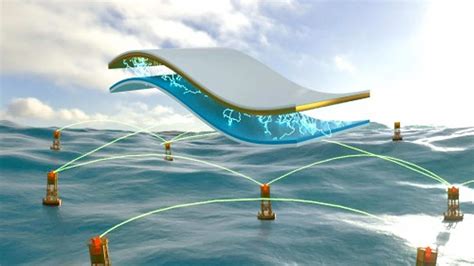Waves as a Renewable Energy Source
With the world facing unprecedented challenges in meeting its energy demands, the search for sustainable and renewable energy sources has intensified. Among the most promising alternatives, wave energy stands out as a vast and largely untapped resource.

Waves contain enormous energy that can be harnessed through innovative technologies. According to the International Renewable Energy Agency (IRENA), the global technical potential of wave energy is estimated at 25 TW, which is equivalent to approximately 10% of the world’s total electricity consumption.
Cap for Waves: Harnessing the Ocean’s Power
Cap for waves refers to a conceptual framework that aims to develop and deploy efficient and reliable technologies for converting wave energy into electricity. These technologies typically involve capturing the kinetic energy of waves and transforming it into electrical energy through generators or other conversion mechanisms.
Benefits of Cap for Waves
The development of cap for waves technologies offers several compelling benefits, including:
- Renewable and Sustainable: Wave energy is a renewable and sustainable energy source that does not deplete or pollute the environment.
- Abundant and Predictable: Waves are a predictable and abundant resource, providing a steady and reliable source of energy.
- High Energy Density: Waves can generate high energy densities, making them suitable for large-scale power generation.
- Potential for Grid Integration: Cap for waves technologies can be integrated into existing electrical grids, providing a decentralized and resilient energy supply.
Challenges in Cap for Waves
Despite the immense potential of cap for waves, several challenges need to be addressed to unlock its full potential. These include:
- Technological Maturity: Cap for waves technologies are still in the early stages of development and require further research and refinement to achieve commercial viability.
- High Capital Costs: The upfront investment in cap for waves projects can be significant, posing a challenge for widespread deployment.
- Environmental Impacts: The environmental impacts of cap for waves technologies need to be carefully assessed and mitigated to ensure sustainability.
Strategies for Advancing Cap for Waves
To accelerate the development and deployment of cap for waves technologies, several effective strategies can be implemented:
- Government Support: Governments can provide financial incentives, research funding, and regulatory support to encourage innovation in cap for waves.
- International Collaboration: Collaborative partnerships between research institutions, industry leaders, and international organizations can foster knowledge sharing and accelerate technological breakthroughs.
- Market Development: Establishing a supportive market environment for cap for waves technologies, including feed-in tariffs and power purchase agreements, can incentivize investment and commercialization.
- Public Awareness: Raising public awareness about the potential of cap for waves can generate support for its development and deployment.
Applications of Cap for Waves
Beyond electricity generation, cap for waves technologies can also be applied to other innovative applications, such as:
- Water Desalination: Wave energy can be used to power reverse osmosis or electrodialysis desalination processes, providing access to fresh water in coastal regions.
- Maritime Transportation: Cap for waves devices can be integrated into marine vessels to reduce fuel consumption and emissions.
- Coastal Protection: Wave energy structures can be designed to dissipate wave energy and protect coastlines from erosion.
Tables: Data and Statistics
| Parameter | Value |
|---|---|
| Global technical potential of wave energy | 25 TW |
| Share of world’s electricity consumption | 10% |
| Estimated levelized cost of energy (LCOE) | $0.10-0.15/kWh |
| Number of wave energy projects in operation (2022) | 8 |
| Country | Installed Capacity (MW) |
|---|---|
| United Kingdom | 3.6 |
| Australia | 2.2 |
| Portugal | 2.0 |
| United States | 1.5 |
| Environmental Impacts | Mitigation Strategies |
|---|---|
| Noise | Sound-absorbing materials |
| Visual impact | Submerged or floating devices |
| Marine life disturbance | Site selection and monitoring |
Frequently Asked Questions (FAQs)
Q: What is the difference between wave energy and tidal energy?
A: Wave energy harnesses the energy of surface waves on the ocean’s surface, while tidal energy utilizes the energy of the tides.
Q: Is wave energy a reliable source of energy?
A: While wave energy is not as predictable as solar or wind energy, technological advancements have improved the reliability of wave energy conversion devices.
Q: What are the limitations of cap for waves technologies?
A: Current limitations include high capital costs, technological maturity, and environmental impacts.
Q: What are the potential applications of cap for waves technologies beyond electricity generation?
A: Cap for waves technologies can be applied to water desalination, maritime transportation, and coastal protection.
Q: What are the challenges that need to be overcome to unlock the full potential of cap for waves?
A: Technological development, high capital costs, and environmental concerns are key challenges that need to be addressed.
Q: What role can governments play in advancing cap for waves technologies?
A: Governments can provide financial incentives, research funding, and regulatory support to accelerate innovation and commercialization.
Q: What is the future outlook for cap for waves technologies?
A: With ongoing technological advancements, supportive policies, and increasing demand for renewable energy, the future outlook for cap for waves technologies is promising.
